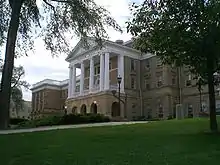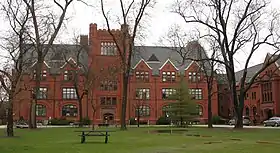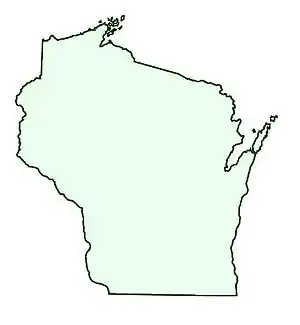University of Wisconsin System
The University of Wisconsin System is a university system of public universities in the U.S. state of Wisconsin. It is one of the largest public higher-education systems in the country, enrolling more than 174,000 students each year and employing approximately 39,000 faculty and staff statewide.[3][4] The University of Wisconsin System is composed of two doctoral research universities, eleven comprehensive universities, and thirteen freshman-sophomore branch campuses.
 | |
| Type | Public university system |
|---|---|
| Established | 1848 |
| Endowment | $604.2 million (2019)[1] |
| President | Tommy Thompson (interim) |
| Students | 182,000 |
| Location | , , United States |
| Campus |
|
| Colors | Red and gray[2] |
| Website | www |
History
The present-day University of Wisconsin System was created on October 11, 1971, by Chapter 100, Laws of 1971, which combined the former University of Wisconsin and Wisconsin State Universities systems into an enlarged University of Wisconsin System. The merger was supposed to take effect in 1973; however, the final legislation did not pass until May 1974. The merger took effect on July 9, 1974, combining two chapters of the Wisconsin statutes. The former Chapter 36 (former University of Wisconsin) and Chapter 37 (former Wisconsin State Universities) were merged to create a new Chapter 36 (University of Wisconsin System).[5]
Former University of Wisconsin
The University of Wisconsin was created by the state constitution in 1848, and held its first classes in Madison in 1849. A second campus was established to the west on the banks of the Mississippi in 1909, and would become the University of Wisconsin–La Crosse.
In 1956, pressed by the growing demand for a large public university that offered graduate programs in Wisconsin's largest city, Wisconsin lawmakers merged Wisconsin State College of Milwaukee (WSCM) and the University of Wisconsin–Extension's Milwaukee division as the University of Wisconsin–Milwaukee. The new campus consisted of both the WSCM campus near the lakefront and the UW extension in downtown Milwaukee.
Starting in the 1940s, freshman-sophomore centers were opened across the state. In 1968, the Green Bay center was upgraded to a full-fledged four-year institution as the University of Wisconsin–Green Bay, while the Kenosha and Racine centers were merged as the University of Wisconsin–Parkside. By 1971, the University of Wisconsin system consisted of campuses at Madison, Milwaukee, Green Bay and Kenosha/Somers, along with 10 freshman-sophomore centers and the statewide University of Wisconsin–Extension.[5] The total enrollment of the University of Wisconsin system at that time was 69,554. The Board of Regents of the University of Wisconsin system consisted of ten members, nine of whom were appointed by the governor and confirmed by the senate for nine-year terms. The tenth was the State Superintendent of Public Instruction who served ex officio on both the University of Wisconsin and Wisconsin State University boards.
Former Wisconsin state universities
In 1866, the state legislature established a normal school at Platteville—the first of eight teacher-training schools across the state. In 1911, the legislature permitted the normal schools to offer two years of post-high school work in art, liberal arts and sciences, pre-law, and pre-medicine. The broadened curriculum proved popular and soon accounted for over one-third of the normal schools' enrollment. In 1920, the Carnegie Foundation for the Advancement of Teaching issued a report on "The Professional Education of Teachers of American Public Schools", which attacked such programs, arguing that normal schools should not deviate from their purpose as trainers of teachers. When the Milwaukee Normal School persisted with its popular enhanced curriculum, the regents of the Normal School system, the legislature, and the governor all became involved. MNS President Carroll G. Pearse was forced to resign in 1923, and the regents ordered the discontinuation of non-teacher-education programs. The issue was not settled, though; public pressure for expanded offerings at normal schools continued to grow, and education professionals asserted that traditional two-year curricula in teacher training were inadequate.
In 1926, the regents repurposed the Normal Schools as "State Teachers Colleges", offering a four-year course of study leading to a Bachelor of Education degree that incorporated significant general education at all levels. The thousands of returning World War II veterans in Wisconsin needed more college choices for their studies under the G.I. Bill, and popular demand pushed the State Teachers College system Regents to once again allow the teacher training institutions to offer bachelor's degrees in liberal arts and fine arts. In 1951 the state teachers colleges were redesignated as "Wisconsin State Colleges," offering a full four-year liberal-arts curriculum. In 1955, the Stout Institute in Menomonie, which had been founded as a private engineering school in 1891 and was sold to the state in 1911, was merged into the Wisconsin State Colleges system; it had previously been governed by a separate state board of regents.
The state colleges were all granted university status as "Wisconsin State Universities" in 1964 (with the exception of Wisconsin State College-Milwaukee, which had become part of the University of Wisconsin in 1956).
As of 1971, the Wisconsin State Universities comprised nine public universities (Platteville, Whitewater, Oshkosh, River Falls, Stout (in Menomonie), Superior, Stevens Point, La Crosse, and Eau Claire) and four freshman-sophomore branch campuses, with a total enrollment of 64,148. The board was made up of 14 members, 13 of whom were appointed by the governor and confirmed by the senate for five-year terms. The 14th was the State Superintendent of Public Instruction.
The University of Wisconsin System
The University of Wisconsin system merged with the Wisconsin State University system in 1971 to create today's University of Wisconsin System. The 1971 merger law approved by the State Senate combined the two higher education systems in Wisconsin under a single Board of Regents, creating a system with 13 universities, 14 (now 13) freshman-sophomore centers (later colleges, now branch campuses), and a statewide extension with offices in all 72 counties. Each university is named "University of Wisconsin–" followed by the location or name. Each two-year college was named "University of Wisconsin–" followed by the city and/or county in which it is located. The move, intended to enhance the University of Wisconsin's prestige and influence, was resisted by some parties concerned with a possible brand dilution.[5]
The Board of the University of Wisconsin System includes 18 members, 16 of whom are appointed by the Governor and approved by the Senate. Of these 16 members, 14 serve staggered, seven-year terms. The remaining two are two-year-term position filled by current UW System students. The two ex officio members are the State Superintendent of Public Instruction and the president or a designee of the Wisconsin Technical College System Board.[5]
Restructuring
In October 2017,[6] UW System president Ray Cross publicly proposed a restructuring of the University of Wisconsin System that would bring the UW Colleges under the control of their nearest comprehensive university, creating regional campuses within the system. The proposal also included moving parts of UW-Extension to UW-Madison and UW System administration. UW Colleges Online, which was operating as an additional campus of UW Colleges, would be relocated under UW System administration. President Cross announced this proposal without consulting shared governance groups or administrators. According to the University of Wisconsin System administration, the merger would save money.[7] Critics said the merger was being rushed without input from the campuses and that the system was buckling to political pressure from the state.[7] The proposal was approved by the UW Board of Regents in their November 2017 meeting, implementation began July 1, 2018.[7][6][8]
Research universities
There are two research universities in the University of Wisconsin System that grant doctoral degrees: the University of Wisconsin–Madison and the University of Wisconsin–Milwaukee. UW-La Crosse also began offering doctoral degree programs in 2007 and now offers two selections.
UW–Madison
Founded in 1848, University of Wisconsin–Madison is the largest university in the state, and the flagship of the UW System, with a total enrollment of approximately 43,000 students, of whom approximately 32,000 are undergraduates.[4]
UW–Milwaukee
The University of Wisconsin–Milwaukee, which traces its history back to 1885, is the second largest university in Wisconsin, with an enrollment of over 30,000 students. The university is categorized as an R1: Doctoral Universities – Highest research activity in the Carnegie Classification of Institutions of Higher Education.[9]
Comprehensive universities
There are eleven comprehensive universities in the University of Wisconsin System that grant baccalaureate and master's degrees:
- UW–Eau Claire (also offers the Doctor of Nursing Practice degree)
- UW–Green Bay (also offers the Doctor of Education in First Nations Education)
- UW–La Crosse (also offers Doctor of Physical Therapy and Student Affairs Administration and Leadership Ed.D degrees)
- UW–Oshkosh (also offers the Doctor of Education and Doctor of Nursing Practice degrees)
- UW–Parkside in Kenosha
- UW–Platteville
- UW–River Falls
- UW–Stevens Point (also offers the Doctor of Audiology degree)
- UW–Stout in Menomonie
- UW–Superior
- UW–Whitewater
The University of Wisconsin–La Crosse began offering doctorates in 2007, the University of Wisconsin–Eau Claire in 2010, and both the University of Wisconsin–Oshkosh and University of Wisconsin–Whitewater in 2012.
Branch campuses
University of Wisconsin Colleges was an institution of the University of Wisconsin System that granted associate degrees at 13 two-year campuses located throughout the state and through an online program. In 2018, the two-year campuses were merged into nearby 4-year universities. Branch campuses include:
- UW–Eau Claire – Barron County
- UW–Oshkosh, Fond du Lac Campus
- UW–Oshkosh, Fox Cities Campus
- UW–Green Bay, Manitowoc Campus
- UW–Green Bay, Marinette Campus
- UW–Green Bay, Sheboygan Campus
- UW–Milwaukee at Washington County
- UW–Milwaukee at Waukesha
- UW–Platteville Baraboo Sauk County
- UW–Platteville Richland
- UW–Stevens Point at Wausau
- UW–Stevens Point at Marshfield
- UW–Whitewater at Rock County
UW–Extension
The University of Wisconsin–Extension operated extension courses statewide through offices in each of Wisconsin's 72 counties. In 2018, UW–Extension merged into UW–Madison.
Controversy
Since the 1971 union of the universities and colleges under the University of Wisconsin System name, there has been a controversy over the arrangement. The name "University of Wisconsin" is often used to refer to the Madison campus, which has made it difficult for other institutions to make names for themselves. Conversely, many who are connected to UW–Madison have claimed that having so many institutions share the "University of Wisconsin" title has caused a form of brand dilution.[10]
In 2006 and 2009, the students at the Milwaukee campus voted on whether the school should change its name to something that didn't carry the UW name (such as Wisconsin State University or University of Milwaukee). In both cases, a plurality of students voted to retain the name "University of Wisconsin–Milwaukee," but over 50% were in favor of a different name.[11] However, since 2004 the UWM athletic department has dropped the UW prefix and simply refers to the school's athletic teams as the Milwaukee Panthers. UW–Green Bay has since done the same and are officially the Green Bay Phoenix. Other UW system programs are commonly referred to by just the city name as they all play in the same conference, the WIAC, making the 'UW' redundant. The exception is UW–Parkside, who plays in the Division II Great Lakes Intercollegiate Athletic Conference and is commonly simply called "Parkside".
References
| Wikimedia Commons has media related to University of Wisconsin System. |
- As of June 30, 2019. "U.S. and Canadian 2019 NTSE Participating Institutions Listed by Fiscal Year 2019 Endowment Market Value, and Percentage Change in Market Value from FY18 to FY19 (Revised)". National Association of College and University Business Officers and TIAA. Retrieved September 25, 2020.
- "Brand Colors | Digital Communication". Wisconsin.edu. 2015-06-11. Retrieved 2015-12-13.
- Student Statistics. University of Wisconsin System.
- 2016-17 Fact Book. University of Wisconsin System.
- History and Organization of the University of Wisconsin System Archived 2007-02-02 at the Wayback Machine. Retrieved on 2007-02-18.
- "Wisconsin merger plan stokes controversy, but some see upside". Inside Higher Ed. Retrieved 2017-10-21.
- "UW System will propose merging two- and four-year campuses to cut costs, raise graduation numbers". Milwaukee Journal Sentinel. Retrieved 2017-10-21.
- "UW Regents Approve Merging System Campuses". Wisconsin Public Radio. Retrieved 2017-11-19.
- Carnegie Foundation for the Advancement of Teaching
- Klotsche, J. Martin. The University of Wisconsin–-Milwaukee: An Urban University, pp. 1–40.
- Jones, Meg. Referendum "UWM students rebuff change: New names such as Wisconsin State University fail in referendum" Archived 2007-09-29 at the Wayback Machine, Milwaukee Journal Sentinel, April 30, 2006.



